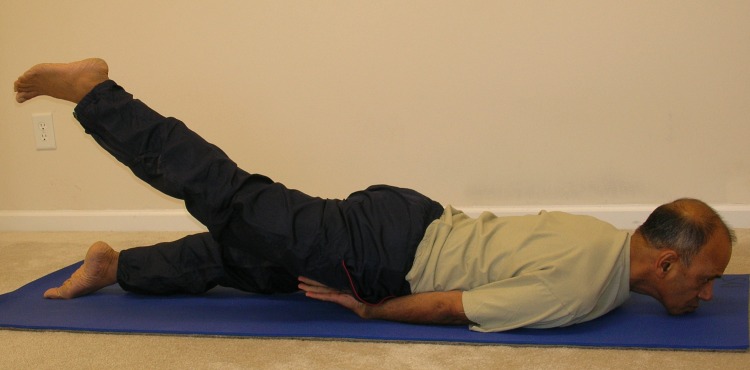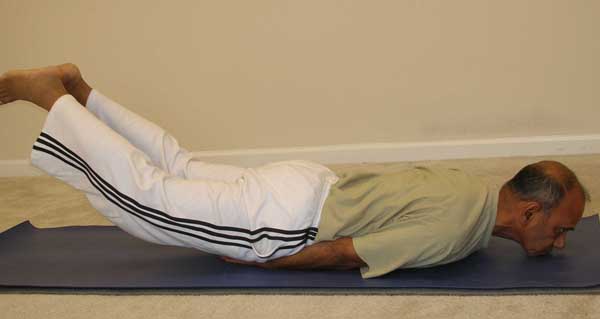In today’s post, we will continue our discussion on the backward bending poses and focus on the pose called Shalabhasana – शलभासन -(Locust Pose). In the final position, the pose resembles the trunk of a locust.
Step-by-step
Round one – Ardha Shalabhasana (Half Locust Pose):
- Lie flat on the abdomen with the hands under the thighs, palms facing upwards. Optionally, you may make a fist with the two hands, keeping the fists together with the elbows stretched straight and tucked in.
- Keep both the legs straight and toes pointing back throughout the practice. Place the chin on the floor, slightly stretched forward to give the best possible stretch to the neck muscles and nerves
- While inhaling, using the back muscles, raise the left leg as high as possible, keeping the other leg straight, relaxed and in contact with the floor. Do not tilt or twist the pelvis
- Retain the position for four to five breaths or as long as comfortable without causing any strain
- While exhaling, lower the leg slowly to the floor and repeat the same movement with the right leg
- Repeat the above routine once more on both sides
Round two – Shalabhasana (Full Locust Pose):
- Repeat steps 1 and 2 as above
- While inhaling, using the back muscles, lift both the legs together slowly, raising the legs as high as possible. Retain the final position for four to five breaths or as long as comfortable.
- Lower the legs to the floor while exhaling and repeat the above routine one more time
- As a variation to the above, you may stretch the hands back and lift your head/chest as well as the legs at the same time
Contraindications/Cautions
Throughout the pose, maintain awareness on the spine and the breath. If at any time you feel discomfort in the spine, or any other part of the body, you should back off and come out of the pose. People with a weak spine should avoid the full Locust Pose and practice only a gentle version of the Half Locust Pose. Those with a weak heart, coronary problems, or high blood pressure should avoid practicing Shalabhasana. Avoid this pose if you suffer from peptic ulcers, hernia, intestinal problems, recent or chronic back injury, or headache. It is not advisable for pregnant women, except for experienced yoga practitioners who can continue to practice it gently (only the Half Locust version, never attempting the full locust) during the first trimester only.
Benefits
- Alleviates disorders of the stomach and bowels, cures flatulence, improves digestion, promotes peristaltic action and helps with constipation
- Helpful for sciatica
- Offers relief in cases of sciatica, slipped disc, varicose veins, hemorrhoids and lower back pain
- Excess fat is reduced especially from the hips, waist, posterior, thighs, and the abdomen.
- Various organs and glands like the reproductive organs as well as the adrenal and prostrate glands are activated
- Stimulates and helps balance the swadhisthana (2nd) and manipura (3rd) chakras


1-i never practiced yoga in my life but i’m interested by this exercise in particularly can i go for it ? or i should know/do any complementary things before that ?
2-you said: “Avoid this pose if you suffer from …., recent or chronic back injury”, and in the benefit chapter, “Helpful for sciatica” in this matter i lifted once a heavy object and since then i have back pains and related or not recently sciatica problems; in this case the locus pose is still indicated for me
Thank you, Lucian, for your kind feedback. In my opinion, it is better to establish a more complete yoga practice including some asanas, pranayama (breathing practices) and meditation. That way the whole body tends to derive the benefits. Shalabhasana can definitely be done as a part of your routine. This asana is supposed to help with sciatica as well. Avoid this pose only if you have severe back pain. Otherwise, a gentle backward stretch that this pose provides can be helpful to relieve mild back pain.
Wishing you all the best.
thank you very much for the answer/ cristal clear ! 🙂
lucian !